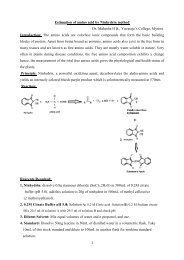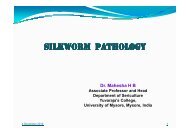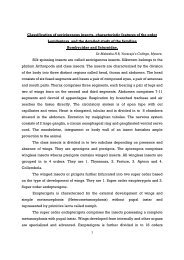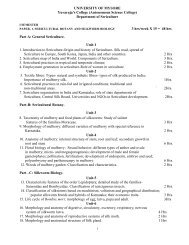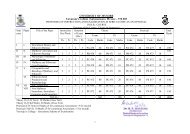silkworm grasserie and pebrine for open elective
silkworm grasserie and pebrine for open elective
silkworm grasserie and pebrine for open elective
Create successful ePaper yourself
Turn your PDF publications into a flip-book with our unique Google optimized e-Paper software.
microbial properties <strong>and</strong> various <strong>for</strong>mulations involving this chemical have been prepared like<br />
Papazol in Japan <strong>and</strong> Reshamkeet Oushadh in India. The latter is a bed disinfectant <strong>for</strong>mulation<br />
containing 1 per cent captan (N-Trichloromythyl Thio-4-Cyclohexane 1,2- Dicarboxymide), 1<br />
percentpara<strong>for</strong>maldehyde (Tri- oxymethylene) 2 per cent Benzoic acid <strong>and</strong> 96 per cent slaked<br />
lime powder giving dual protection against<br />
<strong>grasserie</strong> <strong>and</strong> muscardine. It should be dusted on the larvae <strong>and</strong> bed with the help of a thin cloth<br />
at the rate of 2-3 grams/0. 1 sqm. area during early instars <strong>and</strong> 4- 5 grams/0.1sqm. during IV <strong>and</strong><br />
V instars. The dusting should be done (Fig. 6) preferably once after each moult, half an hour<br />
be<strong>for</strong>e resumption of feed. An additional dusting should be done on the 4th day of final instar<br />
after bed cleaning. The dusting should not be done when the larvae are under moult or preparing<br />
<strong>for</strong> moult. The quantity of Reshamkeet Oushadh required <strong>for</strong> 100 disease free layings (40,000<br />
larvae) is between 3-3.5 kgs.<br />
PROTOZOAN DISEASES<br />
Protozoa which are injurious to <strong>silkworm</strong> are the parasitic ones belonging to the class<br />
Microsporidia <strong>and</strong> genera Nosema, Pleistophora <strong>and</strong> Thelohania. However, the major<br />
protozoan disease of the <strong>silkworm</strong> is the <strong>pebrine</strong> disease, so named due to the appearance of<br />
black peppery patches following infection.<br />
Pebrine<br />
Pebrine is a chronic <strong>and</strong> disastrous disease of the <strong>silkworm</strong> Bombyx mori L. It was this<br />
disease which was responsible <strong>for</strong> the sudden collapse of the <strong>silkworm</strong> industry of both France<br />
<strong>and</strong> Italy in 1965. Even though the fight against this disease in all the sericultural countries is<br />
going on since more than 100 years, the disease is not yet eliminated. However, it has been kept<br />
under check by following the techniques of strict mother moth examination <strong>for</strong> the supply of<br />
disease free <strong>silkworm</strong> eggs, in addition to disinfection <strong>and</strong> hygienic rearings. Though the<br />
4



